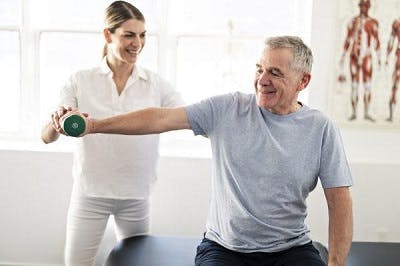If you’re working on recovery after a neurological injury, you’ve likely heard the phrase “use it or lose it.” This is one of the main principles of neuroplasticity, which is the central nervous system’s ability to make adaptive changes based on the behaviors you repetitively perform.
To help you understand this popular neurorehabilitation phrase, this article will discuss:
- What “use it or lose it” means
- Other principles of neuroplasticity
- Is it possible to regain lost functions?
What “Use It or Lose It” Means
To minimize losses after neurological injury, individuals must focus on promoting neuroplasticity to reorganize the central nervous system’s neural circuitry and restore compromised functions. One of the most effective ways to do this is to think “use it or lose it.” It simply means that in order to retain proficiency over a function, you must practice it regularly.
Every function you perform activates a unique set of neural pathways in the central nervous system (the brain and spinal cord). The most frequently activated neural pathways are strengthened and maintained, while those less frequently activated become neglected and forgotten.
This occurs because the central nervous system no longer senses a demand for those functions. Therefore, to be as efficient as possible and save energy for more in-demand functions, it will start to forget how to perform unused functions.
Consequently, prolonged disuse can lead to learned non-use, which refers to the conditioned suppression of affected body parts. For example, when the left arm is weakened by a stroke, individuals tend to compensate by using their unaffected right arm. Consistently using the unaffected arm leads to disuse of the affected arm until eventually, individuals forget how to use their affected arm.
The only way to prevent functions from worsening and becoming useless after a neurological injury is to use them. Repetitively practicing functions affected by neurological injury reinforces demand for them and encourages the central nervous system to reorganize those functions to unaffected regions of the brain/spinal cord. The more you practice affected functions, the stronger the newly rewired functions become.
Now that you understand what “use it or lose it” means, let’s discuss some other principles of neuroplasticity.
Other Principles of Neuroplasticity
While “use it or lose it” is one of the most popular principles of neuroplasticity, the other principles are equally as important to help you understand how to optimize recovery after neurological injury.
Other principles of neuroplasticity include:
- Use it and improve it. In order to get better at a specific function, you must consistently practice it.
- Specificity. The way you train impacts the nature of plasticity. For example, training specific hand movements will help improve hand function after stroke.
- Repetition matters. To strengthen neural circuits for a function, you must repetitively practice that function.
- Intensity matters. The intensity of your training impacts how quickly adaptive changes occur.
- Time matters. Depending on how long it has been since your injury, you may experience different states of plasticity. For example, immediately after injury, the brain experiences a heightened state of plasticity. Therefore, individuals tend to see the most results in the first several months after their injury.
- Salience matters. Your motivation to train impacts neuroplasticity. The more important training is to you, the easier it is for you to participate in it.
- Age matters. Neuroplasticity occurs more readily in younger brains. However, the brain never runs out of neuroplasticity and there is hope for recovery at any age.
- Transference. Promoting neuroplasticity within one set of neural pathways can promote neuroplasticity for similar behaviors. For example, practicing leg exercises can help improve your walking skills.
- Interference. Learning compensation techniques can make it difficult to regain an affected skill.
As you can see, various factors impact how quickly neuroplasticity is activated in the central nervous system. Fortunately, the brain adapts throughout your entire life and even years after your injury, there is always hope for recovery.
Is It Possible to Regain Lost Functions?

While prolonged disuse of affected functions can lead to losing them, it is always possible to relearn them. Any function can be relearned; however, it will take time to re-establish neural pathways for it. In other words, you’ll likely have to start from the beginning to regain lost functions.
This can be achieved by focusing on consistent and repetitive practice. The more you practice, the more rewiring will occur and the stronger neural pathways for that function will become.
While the point of “use it or lose it” is to encourage you to use affected functions to avoid losing them, it is never too late to promote neuroplasticity and relearn them. Even if it has been years since you’ve used your affected body part, there is always hope for recovery.
Use It or Lose It: Key Points
Your brain is always adapting based on the behaviors you consistently perform. After a neurological injury, you may experience various impairments such as difficulties controlling your movements or poor memory.
In order to prevent these functions from worsening, think “use it or lose it.” The more you practice functions affected by neurological injury, the better the central nervous system will get at recognizing the demand for them and utilize neuroplasticity to make adaptive changes.
Even if you’ve “lost” a function due to years of disuse, there is always potential to relearn it by engaging in consistent and repetitive practice. We hope this article helped you understand what “use it or lose it” means and how to enforce it to optimize your recovery outcomes.










